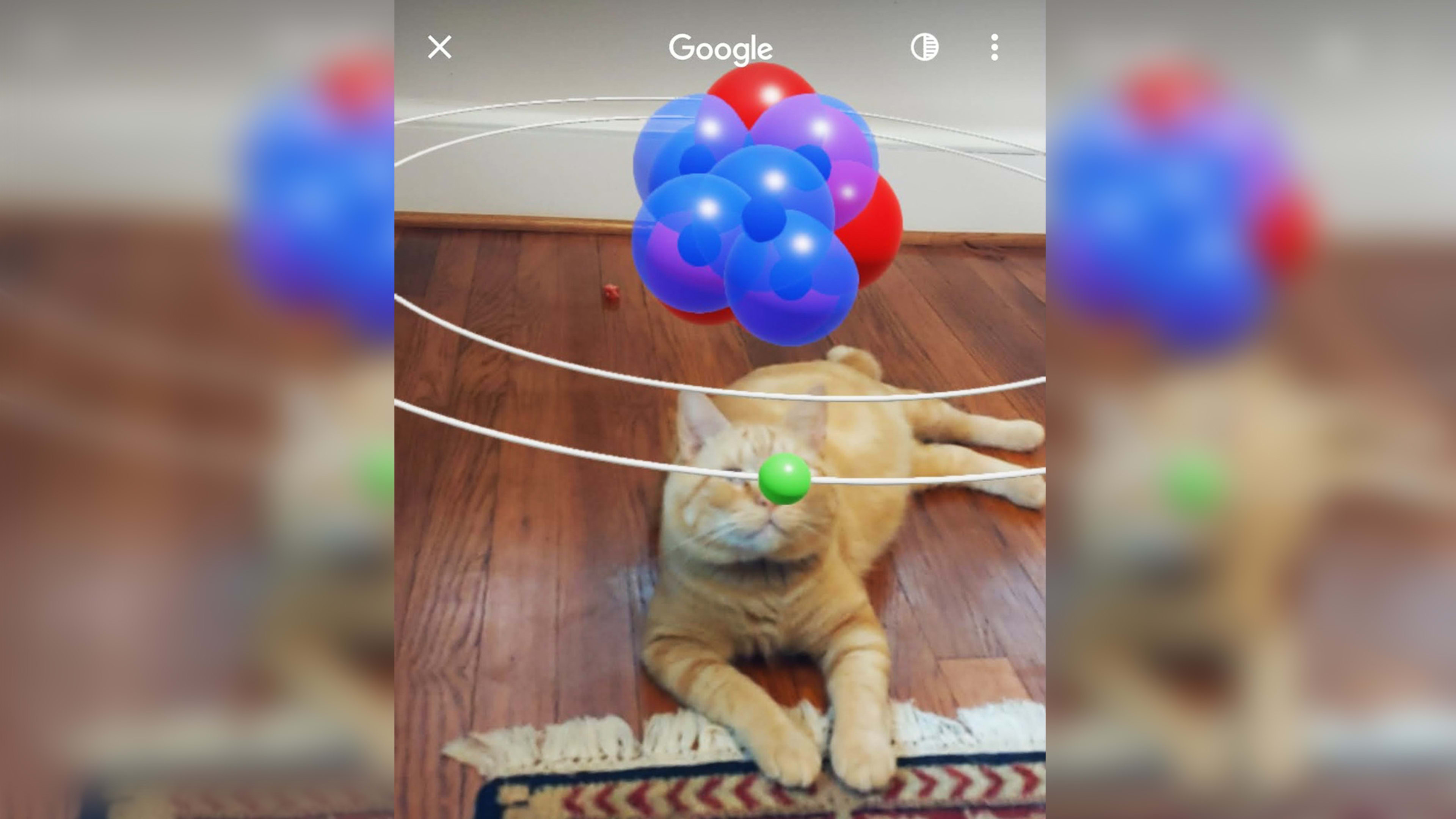Google would like to use your phone’s camera more often—not just for whatever it’s calling its group-chat software this month, but also for augmented-reality overlays of search results on your view of the world.
The search giant has plenty of company in asking you to partake in AR. Apple is making the same request on behalf of iPhone and iPad developers, and Verizon just put in its own bid with a set of AR museum exhibits you can virtually position in your own house.
As seen on the screen of a phone or tablet showing, for example, an animation of a carbon atom’s electrons, neutrons and protons floating above your cat, AR can look legitimately neat.

“This reflects a global challenge that all emerging technologies face,” said Amy Webb, director of the Future Today Institute, a New York-based consultancy. “If the technology is exciting, then what follows is wild speculation about fast market growth, fast penetration and widespread consumer use.”
I reminded Webb of her keynote at the 2016 Online News Association conference, in which she advised newsrooms to invest in AR and evaluate the promising wearable displays of Magic Leap.
That startup is still alive but has no shot at making headborne AR a consumer experience. Webb’s assessment: “The thing that killed Magic Leap was marketing.”
Magic Leap arguably should have seen this coming, since only a few years earlier Google Glass succumbed to the same overdose of hypes—plus the added burden of being shunned as a privacy invasion.
The augmented-reality tools Google touted at its “Search On” event Oct. 15 have the advantage of not requiring you to strap a computer on your head.
Instead, they work like other AR features Google introduced at its I/O developer conference in 2019: Search for a term like “periodic table of the elements” on your phone, for instance, and you can tap a link to have Google float an animated model of an element in front of your surroundings.
[Animation: Google]Google also touted the ability to use its Lens image-search tool to parse equations and coach you through their workings. And an upcoming feature for car shoppers will virtually park your next ride in your driveway (presumably free of fallen leaves and bird poop).
Meanwhile, a growing range of third-party apps also use AR to enhance your perspective. FlightRadar24 overlays flight-path data for airplanes in the sky; Apollo’s Moon Shot AR, companion to a Smithsonian Channel series, let you explore the hardware that took us to the Moon; Apple and Google both provide virtual tape measures; and Amazon and Target’s shopping apps present new furniture in your own rooms.
“What has surprised me most about AR is how relatively unimportant the headsets or glasses have ended up being to consumers, and that this hasn’t stopped 3D content from exploding everywhere,” emailed Dan Pacheco, a professor of journalism innovation at Syracuse University’s S.I. Newhouse School of Public Communications.
The new AR apps should be buoyed by recent strides in smartphone hardware. For instance, the lidar sensors on this year’s iPad Pro, the iPhone 12 Pro and Pro Max and some high-end Samsung Galaxy smartphone can measure distances much more accurately promise more realistic and responsive on-screen augmented reality.
At the same time, it’s not hard to think of additional apps that would benefit from AR features. Imagine if Zillow’s apps could superimpose values and other real-estate metadata up and down a street, or if NASA’s app would trace the path of the International Space Station across your sky.
Yelp users of a certain age don’t have to wonder how that app might benefit from an AR overlay of Yelp scores of nearby establishments. Its apps included such a feature, called Monocle, a decade ago—well before smartphones were built with AR in mind. Monocle vanished from Yelp’s apps in 2019, but when asked, the company did not say what led it to scrap this option.
Whither the AR headset?
In five years, will we have moved on from carrying AR displays to wearing them?
Telecom analyst Roger Entner of Recon Analytics remains bullish on wearables, thanks to 5G wireless’s ability to power edge computing, in which processing happens at the closest network point. That would reduce the chances of sluggish connectivity getting in the way of the experience.
“I think the hardware will get there,” Entner says. “Especially with edge computing, because then your glasses will become a pure display.”
Pacheco also voices some long-term optimism but said glasses won’t be required.
“I do think that AR glasses will eventually be a transformational trend, but it won’t be the glasses themselves that drive adoption,” he says. “It will be the plethora of 3D content that people want to engage with in more immersive ways.”
Webb, for her part, advises looking to business use cases, where too-expensive-for-consumers gear such as Microsoft’s Hololens promise to help companies save even more money by guiding workers through tricky tasks.
“The real opportunities here are not that exciting to think about,” she says. “They are in the enterprise, which will eventually have a trickle-down effect on every one of us.”
Regardless of which AR gadget you end up staring at, the underlying demand will remain: Pictures and video sometimes can’t tell enough.
“We are three-dimensional creatures whose media is mostly stuck on two-dimensional rectangles,” Pacheco said. “As our content starts to integrate the third dimension in ways that resonate, we gravitate toward it.”
Recognize your brand’s excellence by applying to this year’s Brands That Matter Awards before the early-rate deadline, May 3.
